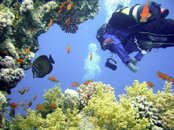Nirvana
Contributor
The impossibility, while doing technical dives, of always having a neutral rig or of having discardable weights makes it more complicated to plan for loss of BCD function than in recreational dives. This is often solved by using a drysuit. This solution, however, presents a problem in places with hot air temperatures. So, for hot air temperatures, warm water technical diving, I've seen four main approaches advocated:
1 - wear a drysuit anyway. This is probably the most straightforward solution. It has the advantage of offering a good deal of buoyancy control with little more effort required from the diver. The downside is a pretty miserable experience while out of the water, especially if no shades are available while doing the setup. It also offers the risk of loss of buoyancy at the surface by having air escape through the neck seal.
2 - use a wetsuit and lift bag. The upside is that a lift bag can offer plenty of buoyancy, surely more than a drysuit. However, it is harder to control precisely and requires constant use of hands to operate, making the use of other tools, such as jon lines, more difficult and adding to the task load. It can also interfere with communication with team members, being right in front of the diver. Moreover, it is argued that divers don't regularly practice making their ascents with lift bags, rendering its successful operation in an emergency less likely.
3 - use a wetsuit and a double bladder wing. It offers redundancy and does not require a change in method of buoyancy control in case of emergency - before the failure the diver adds air by pressing a button on a hose, which can also vent air. After the failure, the operation remains the same, although through a different hose. The downside is that a double bladder wing has more mechanical failure points and is more prone to operator error.
4 - no redundancy, just a wetsuit and a single bladder wing. The reasoning here is that a failure can be coped with. The most likely point of failure for a wing would be the inflator hose, especially where it attaches to the wing. As the wing shouldn't need to be completely inflated in the first place, sufficient buoyancy can be attained simply by adopting a butt up, left shoulder down posture. The downside of this approach is the increased risk of loss of buoyancy during the dive, reduced mobility and difficulty of maintaining buoyancy at the surface. A failure in the butt dump valve would be dealt with in a similar fashion.
That is just a small summary, covering, I hope, the main points of each method. Once again, I am talking about diving in a place that is very warm both above and bellow the water (you can think of Bonaire for reference).
What are your thoughts on the matter, and what is your preferred approach? Any comments are appreciated.
1 - wear a drysuit anyway. This is probably the most straightforward solution. It has the advantage of offering a good deal of buoyancy control with little more effort required from the diver. The downside is a pretty miserable experience while out of the water, especially if no shades are available while doing the setup. It also offers the risk of loss of buoyancy at the surface by having air escape through the neck seal.
2 - use a wetsuit and lift bag. The upside is that a lift bag can offer plenty of buoyancy, surely more than a drysuit. However, it is harder to control precisely and requires constant use of hands to operate, making the use of other tools, such as jon lines, more difficult and adding to the task load. It can also interfere with communication with team members, being right in front of the diver. Moreover, it is argued that divers don't regularly practice making their ascents with lift bags, rendering its successful operation in an emergency less likely.
3 - use a wetsuit and a double bladder wing. It offers redundancy and does not require a change in method of buoyancy control in case of emergency - before the failure the diver adds air by pressing a button on a hose, which can also vent air. After the failure, the operation remains the same, although through a different hose. The downside is that a double bladder wing has more mechanical failure points and is more prone to operator error.
4 - no redundancy, just a wetsuit and a single bladder wing. The reasoning here is that a failure can be coped with. The most likely point of failure for a wing would be the inflator hose, especially where it attaches to the wing. As the wing shouldn't need to be completely inflated in the first place, sufficient buoyancy can be attained simply by adopting a butt up, left shoulder down posture. The downside of this approach is the increased risk of loss of buoyancy during the dive, reduced mobility and difficulty of maintaining buoyancy at the surface. A failure in the butt dump valve would be dealt with in a similar fashion.
That is just a small summary, covering, I hope, the main points of each method. Once again, I am talking about diving in a place that is very warm both above and bellow the water (you can think of Bonaire for reference).
What are your thoughts on the matter, and what is your preferred approach? Any comments are appreciated.





